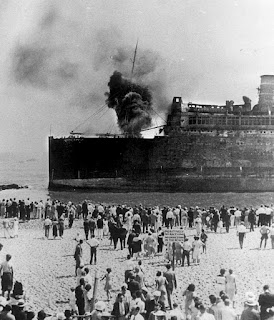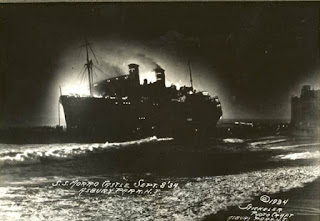The Tragedy of the S.S. Morro Castle: How an Inferno at Sea Created the Jersey Shore's Biggest Tourist Attraction in 1934
Almost immediately, as soon as Officer Warms assumes command of the ocean liner, the weather takes a turn for the worse. The skies off the New Jersey coastline grow cloudy and a strong northeasterly wind begins to blow. Within hours of Warms’ assuming command a full on nor'easter is buffeting the hull of the Morro Castle with pounding waves and gusting hurricane force winds.
Since 1930, for a roundtrip price of $65 (or $1200 in today’s money when adjusted for inflation) the S.S. Morro Castle with its ornate staterooms and countless amenities has shuttled passengers back and forth between New York City and Havana, Cuba in the lap of luxury. Those with the money to spend have been able to escape the bleak reality of Depression Era American life for four days and three nights on their way to a Caribbean paradise aboard the luxurious Morro Castle, all the while, oblivious to the cares of the outside world.
During Prohibition, an era when all of the United States was ostensibly dry according to the letter of the law, the S.S. Morro Castle attracted thousands of passengers who were free to drink all the alcohol they wanted aboard ship while in international waters. From 1930 until 1934 the Morro Castle was America’s first “booze cruise” , one giant, never ending party at sea.
But all of that changes abruptly at around 2:50 in the morning on September 8, 1934 when a fire is first detected in a storage locker on the ship’s B deck. Within minutes the fire has spread and engulfed all of the electrical cables on the ship and the Morro Castle is plunged into complete darkness.
By 3:00 in the morning, less than ten minutes after it first began, the fire is blazing out of control. As frantic passengers and crew struggle to reach the fresh air on deck their lungs are choked by the acrid black smoke that has already begun to fill all passageways below deck on the Morro Castle.
Acting Captain Warms attempts to hastily beach the flaming ship on Long Beach Island just off the southern New Jersey coast, but he is unable to do so when his crew reminds him of the need to launch lifeboats over the side in an effort to save the women and children on board the ship before it’s too late.

Officer William Warms
Reluctantly, and somewhat indecisively, Captain Warms not used to the responsibility of overall command, gives in to the entreaties of his ship’s crew and attempts an evacuation.
But the fire has now spread so out of control that the Morro Castle is only able to transmit one brief SOS message to the world before all communication from the ship is lost as it struggles to stay afloat off Long Beach Island while the flaming ship is being battered by strong wind gusts in excess of seventy miles an hour.
Not accustomed to steering the ship, acting Captain Warms orders the Morro Castle steered away from the shore at Beach Haven, New Jersey, as he attempts to deploy more lifeboats.
In her book Inferno at Sea: Stories of Death and Survival Aboard the Morro Castle, author Deborah C. Whitcraft states, “She (the Morro Castle) was twelve miles from shore when the fire was set. Had he turned the vessel towards shore...I think that more people could have been saved.”
As the Morro Castle drifts farther away from the New Jersey coast, the fire reaches the main deck of the ship, and fueled by the oil based paint on the ship’s exterior, flames soon spread the entire length of the Morro Castle.
In the midst of their misguided evacuation effort the crew of the S.S. Morro Castle is only able to launch six of the ship’s twelve lifeboats. Though these lifeboats are able to carry over 400 passengers only 85 people are able to escape to safety from the floating inferno aboard the ship’s lifeboats.
Tragically, two Coast Guard ships: the USCGC Tampa and the Cahoone are only several nautical miles away from the site of the flaming Morro Castle, on deployment from the Cape May Naval Station, but with the Morro Castle having lost all communication capabilities the two Coast Guard ships remain too far off to see anything amiss right away and take hours to come to the stricken ship’s assistance.
Eventually, local New Jersey radio stations begin to report that dead bodies are washing up on the shore at Point Pleasant Beach, and the Navy in conjunction with the Coast Guard launch a rescue effort to try and save survivors from the Morro Castle.
One of the most tragic aspects of what happened to the Morro Castle is that, to this very day, no one knows exactly how many people were aboard ship the night that it was engulfed by flames.
In the mid 1930’s Cuba was stricken by political strife and turmoil. By offering money to members of the crew many Cubans were able to smuggle their children aboard the ship on its return journey back to New York City where these parents hoped their kids would be able to have a better life living with relatives in the United States. It is estimated that perhaps as many as 200 unaccounted for children from Cuba were illegally smuggled aboard the Morro Castle prior to that fateful night of September 8, 1934.
Out of over 620 passengers and crew believed to have been aboard the Morro Castle on the night of the tragedy only 135 would survive.
Most of the crewmembers aboard the Morro Castle were unpaid, and unskilled laborers, with little or no training who had been brought aboard by Ward Cruise Lines in an effort to save money. In 1934, at the height of the Great Depression most unemployed men were willing to perform any sort of work even for the promise of three meals a day and deferred payment at a later date.
Many members of the crew, seeing an opportunity to acquire free booze, spent the entire trip from Havana to New York in a state of constant and mind numbing intoxication, and therefore even had they wanted to, were in no condition to respond to any type of emergency at sea.
By morning on September 8, 1934 the Morro Castle is a burned out and completely empty hulk floating adrift off the Jersey Shore. The remnants of the Morro Castle drift towards the crowded boardwalk of Asbury Park. Those late summer revellers inside the large convention hall on the Asbury Park boardwalk are fearful that the bow of the ship is going to head straight for them and collide with the boardwalk itself.
It was reported that, “the local government in Asbury Park considered the idea of paying Ward Line Cruises to keep the wreck there permanently.” Most businesses that summer along the Asbury Park boardwalk were closed. Due to the Depression 1934 was one of the worst tourist seasons in the history of the Jersey Shore, but in September of that year once the hulk of the Morro Castle ran aground on the beach at Asbury Park many businesses instantly reopened due to the influx of tourism that the wreck generated.
Beachgoers to Asbury Park in September of 1934 were able to wade out into the surf and touch the side of the burnt out Morro Castle. Pieces of charred metal broken off the side of the ship were sought after souvenirs by everyone in New Jersey.
On March 14, 1935, over six months after the ship first ran aground, Ward Cruise Lines finally towed the wreck of the Morro Castle off the beach at Asbury Park. Some reports state that as it was being towed away from the beach the ship broke apart and sank.
To this day what actually caused the fire that broke out aboard the S.S. Morro Castle remains a mystery. Cuban writer Renee Mendez Capote, a supporter of the Cuban Communist Party and therefore once suspected of having set the fire herself before later being exonerated, was aboard the Morro Castle on the night of September 8, 1934 and she described the event years later saying, “That fire--undoubtedly--is the worst memory I’ve ever had.”
There are many theories ranging from arson by Communists, to a simple electrical fire, to spontaneous combustion of chemicals, as to what caused the tragedy of the S.S. Morro Castle. An official investigation conducted by the state of New York into the tragedy of the S.S. Morro Castle would drag on for over two years but arrive at no concrete conclusion regarding the tragedy at sea.
In the end all that could be said for certain about what happened to the Morro Castle on September 8, 1934 is that a combination of questionable crew members, bad decisions, flammable building materials, poor ship design and bad weather caused a small fire aboard a luxury cruise liner to become perhaps the largest maritime disaster in the long history of the Jersey Shore.
 |
| Bodies that Washed Ashore from the Morro Castle |
On the seventy-fifth anniversary of the Morro Castle disaster, September 8, 2009, a small monument was erected on the side of the Convention Hall at Asbury Park to commemorate the victims near the exact spot where the ship ran aground in 1934.
Many of the victims of the Morro Castle fire are buried in a cemetery in Neptune, New Jersey, close to where their bodies first washed ashore.







Comments
Post a Comment